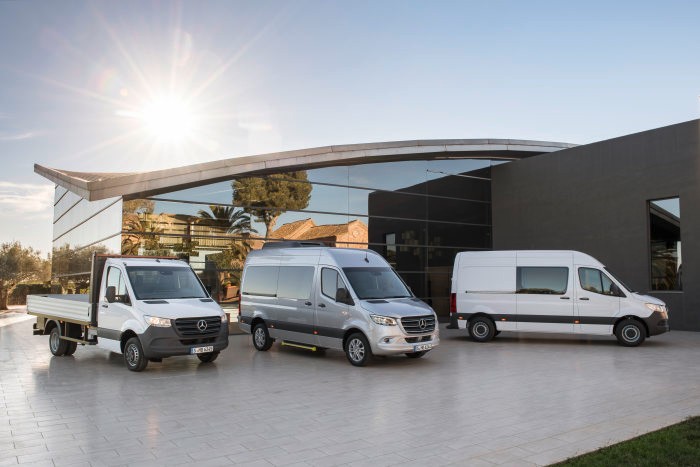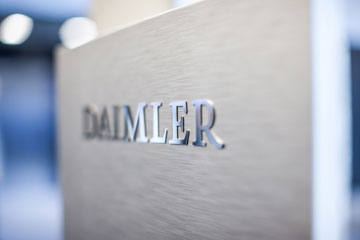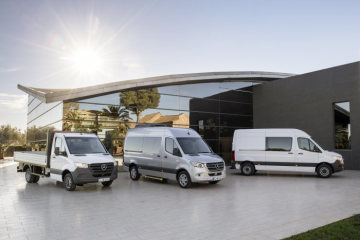
06.
February 2018
Stuttgart/Duisburg
Press Contact for this Press Release (3)
-
Peter Feneberg
- Product Communications Mercedes-Benz Vans
- peter.feneberg@daimler.com
- Tel: +49 711 17-47117
- Fax: .
-
Albrecht Eckl
- Product Communications Mercedes-Benz Citan, Vito, Sprinter
- albrecht.eckl@daimler.com
- Tel: +49 711 17-52131
- Fax: +49 711 17-52038
-
Andrea Eberhardt
- Product Communications Mercedes-Benz Vans
- andrea.eberhardt@daimler.com
- Tel: +49 711 17-77370
- Fax: +49 711 17-91437
- From construction site vehicle to VIP shuttle: a concept to suit any application
- Front-wheel drive makes new entry-level solutions possible for the CEP sector
- Specific adaptation for any transport requirement possible
Bodies, engines, wheelbases or drive configurations: the new Sprinter is hard to beat when it comes to variety. The sectors and applications in which this iconic van is at home are as universal as the Sprinter itself. The following customer segments, applications and their specific challenges are cited here as examples of the numerous possibilities offered by the concept of the new Sprinter – more than ever before. The different applications at a glance:
1. CEP services: efficient and comfortable day-to-day deliveries
Online retailing and the CEP segment (Courier, Express, Parcel services) are two sides of the same coin. Growth has been stable for many years, as every package ordered online also has to be delivered. In 2016, the magic figure of three billion packages was broken in Germany for the first time. This means that the number has almost doubled since 2000. Industry experts expect an increase to over four billion deliveries per year by 2021. The growth rates are even more spectacular when viewed globally: while global parcel deliveries totalled around 44 billion in 2014, this figure grew by almost 48 percent in the space of two years to 65 billion parcels (source: Pitney Bowes 2017 – Parcel Shipping Index). This trend is far from flattening out – various studies still expect annual growth rates between six and eight percent per year through 2025. Only very few other sectors enjoy similar growth prospects.
As efficiency decreases over the last delivery mile in view of the strong growth in B2C, average earnings per consignment are continuously declining. This makes maximum efficiency the order of the day for the CEP sector. The avoidance of empty runs and the reduction of loading and unloading times are major control levers with a direct effect on profit margins. The ergonomic design of the delivery vehicles also helps to make workflows fast and effective, and avoid idle times or downtimes.
Cost-effectiveness is the top priority in the buying decision of many individual entrepreneurs. But the possibility of efficient, health-preserving working procedures is also a basic requirement. For example, the cab must be the perfect workplace, the loading sill should be low for easy loading and unloading, and the portfolio should include a favourably priced entry-level version for delivery transport.
The new Sprinter is the ideal partner for the CEP sector. Thanks to its front-wheel drive, the load compartment floor is 80 millimetres lower than on the predecessor. This immediately pays off in two ways: For the same body height, the additional space fully benefits the cargo capacity. But above all, the driver is able to get in and out at the rear more easily even without a step – a significant workload reduction with up to 180 deliveries per day. The ergonomics are also improved by the "driver's seat Plus" with its flattened seat cushion for frequent entry and exit. Front-wheel drive also gives the new Sprinter a significant weight advantage. The panel van relevant to the CEP sector weighs up to 50 kilograms less than the real-wheel drive. In the 3.5-tonne weight class, it is a particularly economical entry-level solution with the 84 kW base engine. With additional attributes such as loadable wheel arches or the optimised load compartment illumination by LED strips, the new Sprinter becomes the new benchmark in the CEP sector.
Particularly interesting for small and medium CEP fleets: with the market launch of the new Sprinter, Mercedes PRO connect provides eight connectivity packages that make for greater efficiency, lower operating costs, improved vehicle availability and optimised communication within the fleet. This considerably relieves the workload of managers, fleet management, controllers, dispatchers and drivers.
2. eGrocery: The food delivery sector is booming
The market for deliveries of fresh food has a gigantic growth potential. It is estimated that only around 0.6 percent of all food in Germany is ordered online (online survey by McKinsey). However, eGrocery is expected to show strong growth in the Sprinter's relevant key European markets and in the USA. McKinsey expects an annual growth rate of around 14.7 percent for online food orders in Germany through 2020, and forecasts a corresponding increase of 6.0 percent in Great Britain, 10.5 percent in France and 11.0 percent in the USA.
Time and cost pressure rules in this sector. Which means that workflows must be designed as efficient as possible. Ergonomically shaped seats and a low loading are factors in this regard. Just as important are the highest possible payload, as in the new Sprinter with front-wheel drive, and the systematic avoidance of downtimes. Assistance systems and the intelligent Maintenance Management of Mercedes PRO connect meet these requirements.
Transporting such perishable goods poses further challenges for the industry. In view of the enormous cost pressures in the industry, the extensively automated logging and loading of goods will be more and more imperative in future. But it is also all about professionalism. Because for small businesses to survive, the fleet's TCO must be as positive as its suitability for the hard daily routine: easy loading and unloading, absolute reliability and the certainty that the goods will reach the customer in perfect condition.
But above all, the van must fit the company's image. Especially in urban areas, online labels with only a few vehicles are establishing themselves as direct delivery services for regionally and organically grown fruit or vegetables, and they attach importance to their "carbon footprint". Success in this sector is inseparably linked to sustainability.
The new Sprinter ticks all the boxes. A low loading sill or Keyless Start are features that make the working day considerably easier and improve efficiency when delivering food. In tight parking and manoeuvring situations, the Parking package with Parking Assist and reversing camera really comes to the fore. It warns the driver of obstacles with a visual and an audible alert. The sensors cover all areas in front of, next to and behind the vehicle.
With its low-emission engines the new Sprinter already supplies the best arguments for sustainability and its suitability as a refrigerated or delivery vehicle. An aspect that becomes even more important with the introduction of electrically powered variants.
3. Service: New options beyond the classic requirements
Service technicians use their vehicle as a mobile parts warehouse and for transporting the necessary workshop equipment. Driving is not the principal activity of the business – it is a means to an end. The vehicle is the only way to get to the scene quickly and efficiently, and find solutions for any challenge on site. The customer requirements in the service sector include e.g. a load compartment that can be individualised with shelving systems or a workbench. Equally important is use of the cab as a workplace to process customer orders, but above all the purchase price and operating costs must be low. The pressure to become more efficient is also growing in this traditional sector. First and foremost, connectivity solutions are creating opportunities for optimisation or are even changing the business case.
Materials and workshop management is one example of this. In-Van-Delivery, where the vehicle is loaded with e.g. replacement parts overnight, is becoming increasingly popular but also poses new challenges. Firstly, suppliers need to be given a key to the vehicle, and secondly, surplus parts are not removed when restocking the vehicle. The smart-return-box could provide the answer in future. There is no longer any need to juggle a bunch of keys, while unlocking can be limited to a certain time window if the vehicle is unlocked by a mobile phone app using modern connectivity services. Modern MBUX multimedia systems, which register the changing traffic situation practically in real time and dynamically adapt the routing accordingly, offer substantial cost and time savings.
State-of-the-art shelving solutions make for tidy and orderly load compartments. At the front, the driver and co-driver have a wealth of stowage facilities which can be tailored to the particular user profile and the everyday requirements.
However, the decisive factor for the service sector is that the wide portfolio of the new Sprinter also provides the suitable basis: for example, the front-wheel drive panel van with high roof provides generous space for parts and workshop equipment. It also has an 80 millimetres lower entry and loading height than the preceding model – which benefits the available interior height. The 84 kW base engine also impresses with a low purchase price and great economic efficiency in urban transport. Optimal power transfer is ensured by the new 9-speed automatic transmission with torque converter or the likewise newly developed 6-speed manual transmission.
4. Passenger transport: comfortable for passengers, efficient for operators
The passenger transport segment involves different target groups, each with their own specific requirements. Operators expect a reliable vehicle with which they can address the cost pressures in public and private passenger transport. Factors important to the driver are seating quality and the ergonomic design of the working area. If vehicles are used to provide shuttle services and promote the image of the company, quality and modern design are just as important as a luxurious and comfortable interior.
New mobility concepts, which also cover rural areas, require more individualisation of local public transport. Fixed routes and times will become a thing of the past. The vision of individualised public transport becomes possible with connectivity services. Passengers can use an app to request the new Sprinter. In this future scenario, submitted requests are displayed automatically in the telematics system, which automatically adapts the route giving due attention to the current traffic situation. The new Sprinter not only receives but also sends data. In future, seat sensors will register the number of passengers, report it to the app and reconcile the requests and available capacity. This ensures optimum utilisation of the service.
However, passengers not only wish to be transported from A to B, but also want to make good use of their time in the Sprinter in the greatest possible comfort. The interior concept of the new Sprinter is perfectly tailored to passenger needs also in terms of digitalisation: USB charging facilities ensure an adequate power supply, and an optional WiFi hotspot provides passengers with their own individual connections to the digital world. The centrepiece is the MBUX multimedia system, which is controlled via touchscreens or the multifunction steering wheel.
The enhanced value appeal at passenger car level in the cab and the rear area meets the different expectations and needs of all target groups. Thanks to the optional air suspension, passengers enjoy the comfort level they are accustomed to in a car. The air conditioning system positioned on the roof allows individual climate control settings in the passenger compartment, while the auxiliary heating creates a feel-good atmosphere on every seat.
Finally, and especially in shuttle operations, it is the right product concept that determines the character: In conjunction with the 7G-TRONIC automatic transmission, it is in particular the only six-cylinder in the large van segment that enables the new Sprinter to master even the most demanding jobs in passenger transport with superior aplomb.
Safety also plays a central role. Innovative safety and assistance systems at passenger car level support the driver. Examples in this regard include the radar-based DISTRONIC adaptive cruise control system, Active Brake Assist, Active Lane Keeping Assist and ATTENTION ASSIST. Crosswind Assist is also on board as standard. The optional Parking package including a 360-degree camera in conjunction with the 10.25-inch MBUX multimedia system helps the driver to master confusing situations. Traffic Sign Assist draws additional attention to speed limits, no-entry and no-overtaking restrictions and their cancellation. The Wiper System with rain sensor is also new in the Sprinter. The washer fluid is passed through the wiper arms, sprayed directly ahead of the wiper blades and immediately wiped away.
5. Construction sector: high performance even in extreme conditions
Construction transport not only involves short distances, but often also long journeys on motorways and country roads to reach the construction site. The crew naturally wishes to cover the distance as quickly and comfortably as possible. But the last hundred metres are often over rough terrain – through mud, sand and stones. And once they have arrived on site, vehicles are not treated with kid gloves.
Good to know that one can rely on a partner capable of meeting all requirements. Construction companies attach importance to powerful vehicles with a high tonnage – especially if they are often used on construction sites. They also want a van to be capable of taking a punishment yet still remain reliable, even in tough operating conditions and with frequent driver changes. Unplanned repairs are most unwelcome, as the crew's performance depends entirely on the vehicle's flawless operation.
Once on site, the new Sprinter shows its mettle. In conjunction with the on-demand all-wheel drive, it is configured for a gross weight of up to five tonnes – which also makes it ideal as a construction site vehicle for heavy bulk materials. A towing capacity of up to 3.5 tonnes also allows transporting heavy working equipment. And because clothing and shoes rarely stay clean on construction sites, the new Sprinter is highly impervious.
6. Tradespeople: image-promoter and all-rounder
Comparatively small fleets are predominant in the trade sector with its small and medium-size companies. The requirements of the different trades vary greatly. While roofers, tilers or carpenters are also interested in maximum payload and the integration of shelving systems for a mobile workshop, house painters are looking for a large cargo volume to transport ladders or scaffolding. Expectations are correspondingly high with respect to the versatility and flexibility of the few vehicles in the fleet. But all-round talents are also in demand within companies in the trade sector. Often enough the proprietor will be personally behind the wheel, and when visiting customers the Sprinter also takes on a representative role. Elsewhere its qualities as a workhorse for carrying materials are in demand, and with bench seats installed, the Sprinter must also perform well when as many employees as possible must reach the job site at the same time.
The new Sprinter meets the differing requirements with respect to e.g. load-carrying capability or a high-quality interior ambience with its wide range of options. Hard-wearing materials are also able to withstand high mechanical stress. If the working day is less robust, the workplace in the cab can also be adapted to meet high standards.
The Sprinter also shows this adaptability in the load compartment. A metal load compartment floor as standard equipment in the panel van covers the vast majority of needs. A heavy-duty floor is also available as an alternative for heavy loads – this is ideal for Sprinter in which the load is distributed over just a few points in the load compartment, for example in the case of shelving systems or particularly heavy or bulky items. If the load can be distributed more evenly, a new lightweight plastic floor comes into its own and increases the scope with respect to payload.
7. Special jobs: precious furniture can be accommodated just as well as bulky crates or heavy pallets
When bulky or heavy items such as interior fittings or made-to-measure furniture have to be carried, every last cubic centimetre of load capacity and an exemplary payload are called for. Small business owners such as carpenters or manufacturers of specialist furniture use their van both when purchasing heavy raw materials such as timber and to deliver finished products to customers or exhibition sites. Also where its external effect is concerned, the vehicle is directly related to the quality claims the owner makes for his own work.
With wheelbases of up to 4325 millimetres (rear-wheel drive) or 3924 millimetres (front-wheel drive) and a load compartment volume of up to 17 cu. m., the new Sprinter provides the ideal conditions in this regard. If the usable width of the load compartment is of prime importance, the super-single variant is the answer: despite a gross vehicle weight rating of five tonnes, it has single rear tyres. This leaves an available loading width of around 1.22 meters between the wheel arches, so that pallets can also be loaded sideways. As a positive side-effect, the single tyres help to save toll charges and tax in some countries.
The special supports in the entry boxes of the sliding door also show how well the new Sprinter is prepared for carrying bulky goods. These ensure that Euro-pallets or crates are more stable when cornering, and make for particularly safe transport. The robust, washable panelling on the load compartment walls underlines the suitability of the new Sprinter for special transport assignments.
Thanks to its connectivity solutions, the new Sprinter is always in contact with the company. Engines with up to 140 kW allow a car-like driving performance, while the latest assistance systems ensure a high safety level even with constant driver changes. And the outstanding ride comfort on all seats creates a pleasant atmosphere even on long journeys.
8. Camper vans: from panel van to traction head
The camper van market has grown continuously for almost ten years. Over 95,000 vehicles were registered in Europe in 2016, and almost 58,000 in the USA. In Germany alone, sales revenue of new vehicles increased from just under two to over four billion euros between 2009 and 2016. Alongside the trend towards panel vans and semi-integrated vehicles, an increasing desire for individualisation and comfort can be particularly observed in the upper price segment. For example, "best-agers" fulfilling their life's dream with a luxurious camper van costing between 80,000 and 160,000 euros are unwilling to go without conveniences that are considered normal in the premium car sector.
As fragmented as the camper van market might be, the new Sprinter has the ideal solution for every segment (panel van, semi-integrated, alcove or fully integrated). Its wide choice of drive configurations – front-wheel, rear-wheel or all-wheel drive – covers every conceivable application. At the same time, all variants benefit from new technologies such as the new MBUX multimedia systems, the operating and display concept in the cockpit, the value appeal on par with passenger cars, the optional heated and pivoting power luxury seats, and state-of-the-art assistance systems. The electric parking brake is a USP in the segment of large vans. This has a particular benefit in terms of convenience: access from the cab to the living area is made easier thanks to the absence of a parking brake lever.
The new Sprinter also ushers in the digital age for camper vans. Because with the new digital control possibilities, a Sprinter-based camper van becomes a "smart home", and therefore a real "smart camper". The digital communication module, available in the Sprinter for the first time, connects the camper van with the Internet. It e.g. enables the vehicle's location to be established, or the fuel level or next due service to be checked. In addition, "Live Traffic" provides the latest traffic information so that the most favourable route can be chosen at all times. It also takes into account overhead clearances, narrow stretches and weight restrictions.
In future, a new interface module will create the basis for intelligent connectivity between the vehicle, the body and its functions. This will enable all the vehicle statuses to be controlled from one place – via the auxiliary display in the camper van or by smartphone. The Mercedes-Benz Camper App will then allow access to the vehicle from anywhere in the world – for example to check the fill levels of gas and waste water or to perform a check of the vehicle and the body before the start of the journey. This will e.g. allow the heating to be switched on in good time after a day on the ski slopes, so that the camper van can welcome the family with cosy temperatures. The vehicle and living area will combine to form a smart unit that has no equal in the camper van market.
The high quality assistance systems for the basic vehicle considerably heighten the attractiveness of the vehicle as a whole: these include the radar-based DISTRONIC adaptive cruise control, Brake Assist, Active Lane Keeping Assist and ATTENTION ASSIST. Crosswind Assist is of course also on board as standard, as it makes camper van journeys considerably safer, especially at higher speeds.
The front-wheel drive traction head available for the first time is particularly interesting for the strong growth segment of camper vans – which currently accounts for around one third of the market. It is especially impressive when equipped with the 130 kW/400 Nm OM 651 diesel engine exclusively available for camper vans. In conjunction with the new 6-speed manual transmission or the newly available 9-speed automatic transmission, it makes possible high cruising speeds with maximum quiet-running and ride quality, and optimised fuel consumption. As for all other variants, all-season tyres developed especially for long idle times are for the first time available for the traction head. The chassis with cowl is a further variant of the traction head. It provides the ideal basis for fully integrated camper vans. Vehicles with up to three axles and a maximum weight of up to 5500 kilograms can be designed and realised on this basis. The air suspension system configured for the needs of camper vans guarantees outstanding ride quality on long journeys, and low body roll.
Numerous pre-installations were developed for fully integrated camper vans, which make the use of exclusive features possible in this class for the first time or make it easier for body manufacturers to integrate modern assistance systems and convenient extras. These include pre-installations for windscreen heaters, reinforced seat bases with three-point seat belt or pre-installations for DISTRONIC or Blind Spot Assist.
In recent years, the market share of converted panel vans has shown particularly strong growth, and is currently just under 40 percent. Thanks to its front-wheel drive, the new Sprinter opens up further application areas. Decisive advantages include the higher payload (plus 50 kilograms compared to the previous model with rear-wheel drive) and the lower vehicle floor (minus 80 millimetres), which provides more space for interior fittings and facilitates entry even without an additional step. Three diesel variants developing between 84 and 130 kW ensure the dynamism that is important in this vehicle segment. The panel van variants with a total of three different wheelbases, three body heights and five weight classes particularly benefit from the extensive package of technologies used to reduce noise and vibrations. The optionally available, selectable all-wheel drive expands the range of applications. Of particular interest for campers: in the "Hibernation Mode" available for all variants, the vehicle can be put into hibernation by reducing its energy consumption to a minimum. Once Hibernation Mode is switched off, the Sprinter can be started without difficulty even after an extended break.
Front-wheel drive is designed specifically for the needs of the European camper van market and expands the product range of rear-wheel drive and all-wheel drive. In the USA, rear-wheel drive remains the predominant concept. With no 3.5-tonne limitation, powerful petrol engines are part of the requirements specification. A powerful petrol engine in conjunction with the 7G-TRONIC automatic transmission provides the best prerequisites for this – not least thanks to the gross vehicle weight rating of up to five tonnes.
Download
Filter
Show thumbnails
Show list
Slideshow

Do you really want to delete the data record?
Please wait a moment …
Please wait a moment …
Please wait a moment …
Please wait a moment …

LoadingOriginal Article




